Tourism and Kakadu National Park
VerifiedAdded on 2020/03/16
|12
|2722
|43
AI Summary
This assignment analyzes the multifaceted impact of tourism on Kakadu National Park in Australia. It delves into the economic benefits and challenges, examines the interplay between tourism and Aboriginal culture, and explores the environmental consequences of visitor activity within this World Heritage-listed site.
Contribute Materials
Your contribution can guide someone’s learning journey. Share your
documents today.
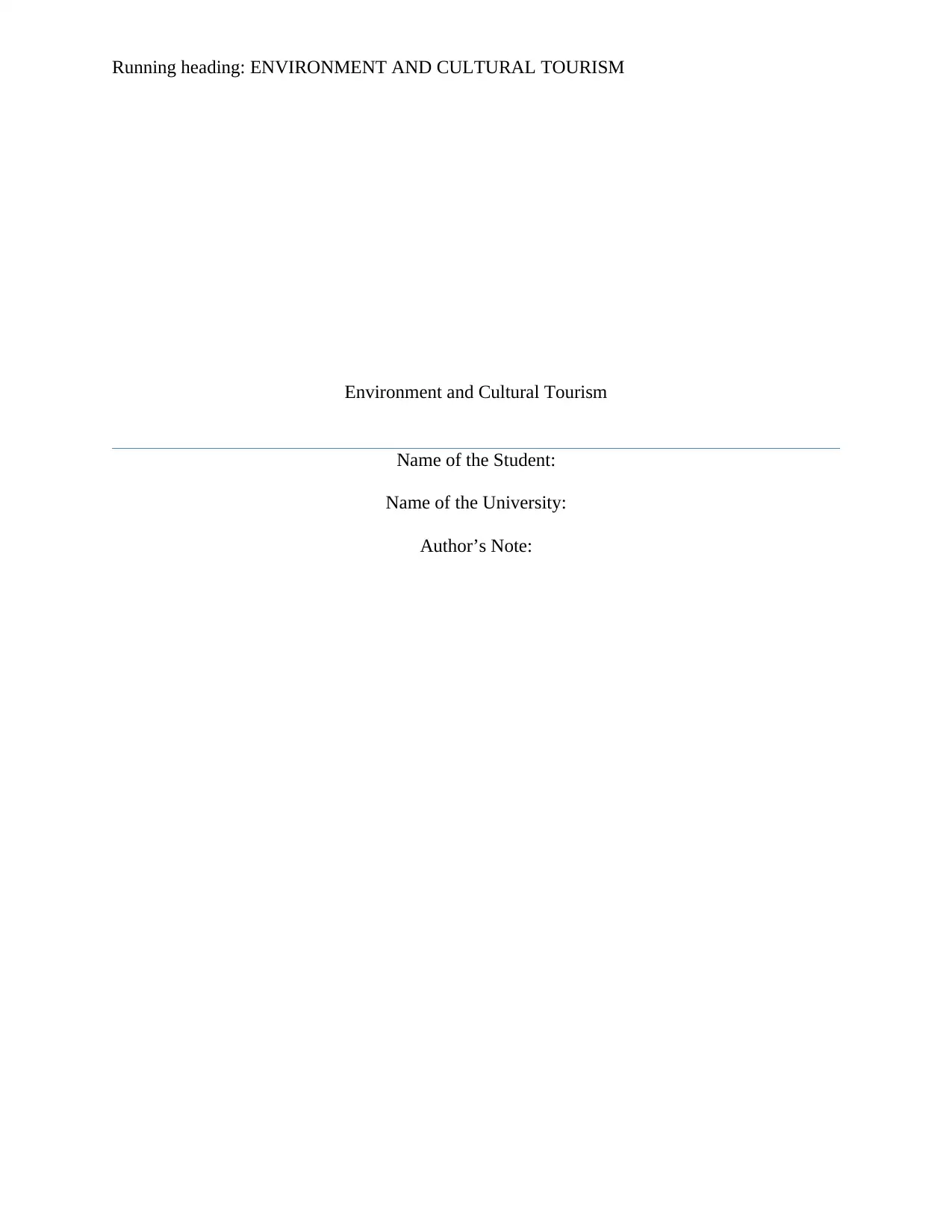
Running heading: ENVIRONMENT AND CULTURAL TOURISM
Environment and Cultural Tourism
Name of the Student:
Name of the University:
Author’s Note:
Environment and Cultural Tourism
Name of the Student:
Name of the University:
Author’s Note:
Secure Best Marks with AI Grader
Need help grading? Try our AI Grader for instant feedback on your assignments.
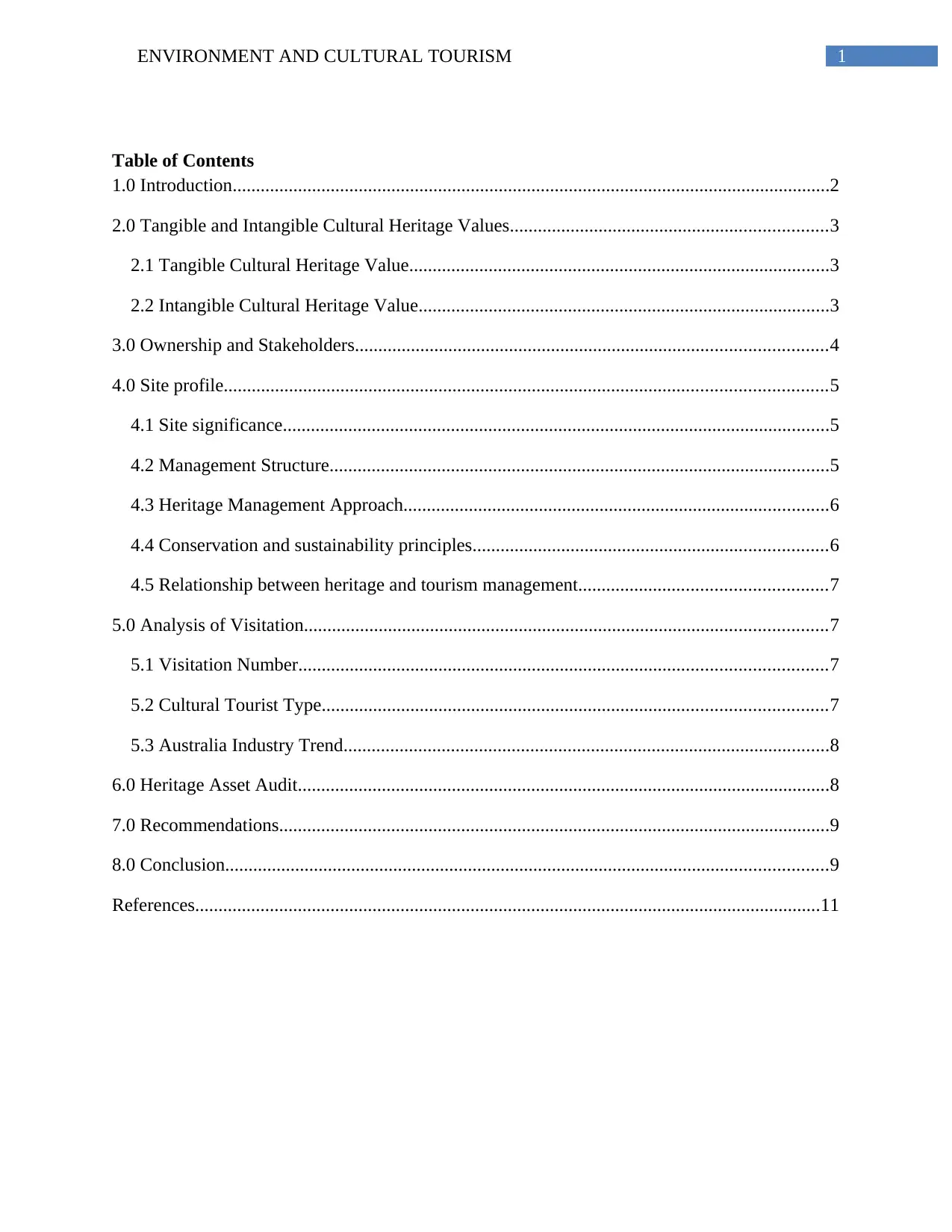
1ENVIRONMENT AND CULTURAL TOURISM
Table of Contents
1.0 Introduction................................................................................................................................2
2.0 Tangible and Intangible Cultural Heritage Values....................................................................3
2.1 Tangible Cultural Heritage Value..........................................................................................3
2.2 Intangible Cultural Heritage Value........................................................................................3
3.0 Ownership and Stakeholders.....................................................................................................4
4.0 Site profile.................................................................................................................................5
4.1 Site significance.....................................................................................................................5
4.2 Management Structure...........................................................................................................5
4.3 Heritage Management Approach...........................................................................................6
4.4 Conservation and sustainability principles............................................................................6
4.5 Relationship between heritage and tourism management.....................................................7
5.0 Analysis of Visitation................................................................................................................7
5.1 Visitation Number.................................................................................................................7
5.2 Cultural Tourist Type............................................................................................................7
5.3 Australia Industry Trend........................................................................................................8
6.0 Heritage Asset Audit..................................................................................................................8
7.0 Recommendations......................................................................................................................9
8.0 Conclusion.................................................................................................................................9
References......................................................................................................................................11
Table of Contents
1.0 Introduction................................................................................................................................2
2.0 Tangible and Intangible Cultural Heritage Values....................................................................3
2.1 Tangible Cultural Heritage Value..........................................................................................3
2.2 Intangible Cultural Heritage Value........................................................................................3
3.0 Ownership and Stakeholders.....................................................................................................4
4.0 Site profile.................................................................................................................................5
4.1 Site significance.....................................................................................................................5
4.2 Management Structure...........................................................................................................5
4.3 Heritage Management Approach...........................................................................................6
4.4 Conservation and sustainability principles............................................................................6
4.5 Relationship between heritage and tourism management.....................................................7
5.0 Analysis of Visitation................................................................................................................7
5.1 Visitation Number.................................................................................................................7
5.2 Cultural Tourist Type............................................................................................................7
5.3 Australia Industry Trend........................................................................................................8
6.0 Heritage Asset Audit..................................................................................................................8
7.0 Recommendations......................................................................................................................9
8.0 Conclusion.................................................................................................................................9
References......................................................................................................................................11
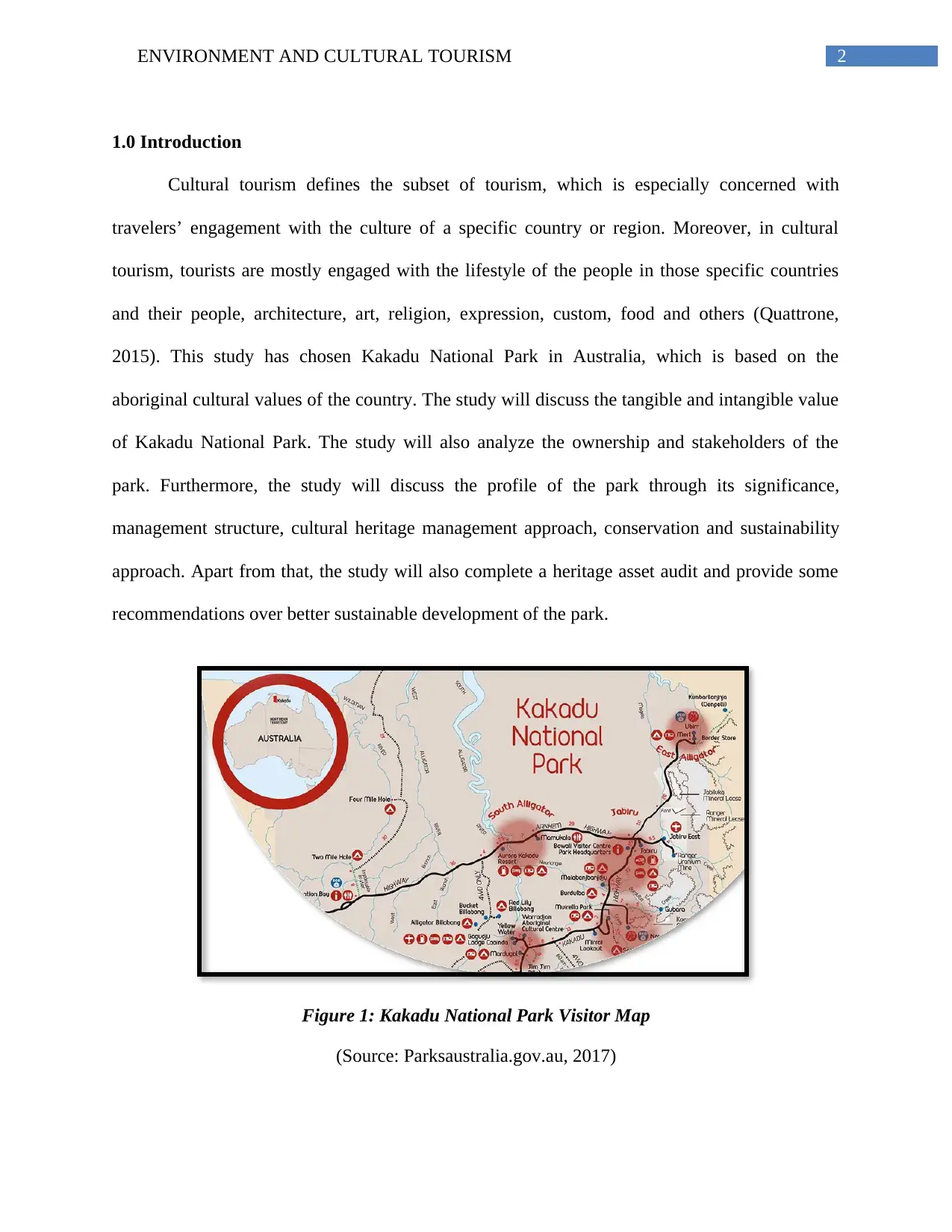
2ENVIRONMENT AND CULTURAL TOURISM
1.0 Introduction
Cultural tourism defines the subset of tourism, which is especially concerned with
travelers’ engagement with the culture of a specific country or region. Moreover, in cultural
tourism, tourists are mostly engaged with the lifestyle of the people in those specific countries
and their people, architecture, art, religion, expression, custom, food and others (Quattrone,
2015). This study has chosen Kakadu National Park in Australia, which is based on the
aboriginal cultural values of the country. The study will discuss the tangible and intangible value
of Kakadu National Park. The study will also analyze the ownership and stakeholders of the
park. Furthermore, the study will discuss the profile of the park through its significance,
management structure, cultural heritage management approach, conservation and sustainability
approach. Apart from that, the study will also complete a heritage asset audit and provide some
recommendations over better sustainable development of the park.
Figure 1: Kakadu National Park Visitor Map
(Source: Parksaustralia.gov.au, 2017)
1.0 Introduction
Cultural tourism defines the subset of tourism, which is especially concerned with
travelers’ engagement with the culture of a specific country or region. Moreover, in cultural
tourism, tourists are mostly engaged with the lifestyle of the people in those specific countries
and their people, architecture, art, religion, expression, custom, food and others (Quattrone,
2015). This study has chosen Kakadu National Park in Australia, which is based on the
aboriginal cultural values of the country. The study will discuss the tangible and intangible value
of Kakadu National Park. The study will also analyze the ownership and stakeholders of the
park. Furthermore, the study will discuss the profile of the park through its significance,
management structure, cultural heritage management approach, conservation and sustainability
approach. Apart from that, the study will also complete a heritage asset audit and provide some
recommendations over better sustainable development of the park.
Figure 1: Kakadu National Park Visitor Map
(Source: Parksaustralia.gov.au, 2017)
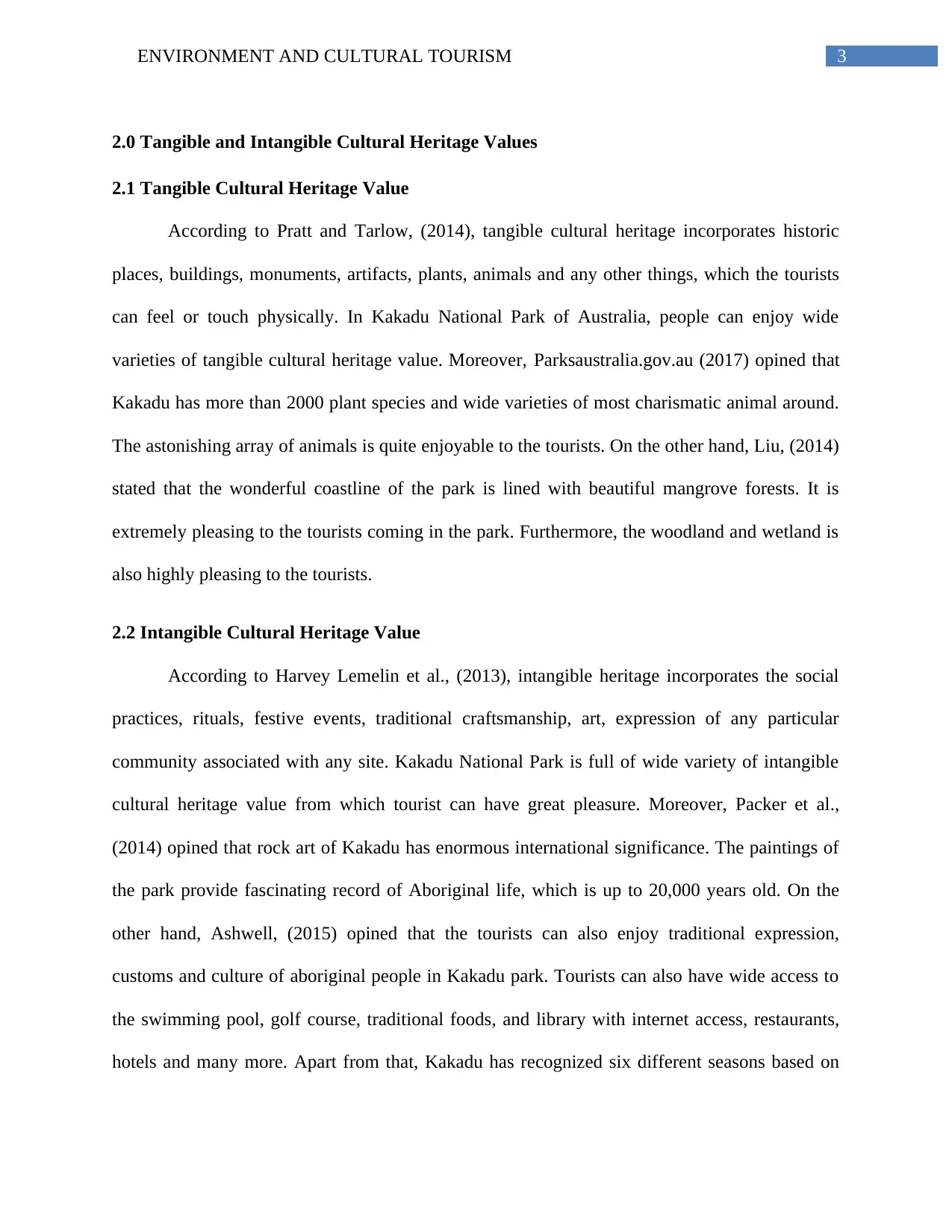
3ENVIRONMENT AND CULTURAL TOURISM
2.0 Tangible and Intangible Cultural Heritage Values
2.1 Tangible Cultural Heritage Value
According to Pratt and Tarlow, (2014), tangible cultural heritage incorporates historic
places, buildings, monuments, artifacts, plants, animals and any other things, which the tourists
can feel or touch physically. In Kakadu National Park of Australia, people can enjoy wide
varieties of tangible cultural heritage value. Moreover, Parksaustralia.gov.au (2017) opined that
Kakadu has more than 2000 plant species and wide varieties of most charismatic animal around.
The astonishing array of animals is quite enjoyable to the tourists. On the other hand, Liu, (2014)
stated that the wonderful coastline of the park is lined with beautiful mangrove forests. It is
extremely pleasing to the tourists coming in the park. Furthermore, the woodland and wetland is
also highly pleasing to the tourists.
2.2 Intangible Cultural Heritage Value
According to Harvey Lemelin et al., (2013), intangible heritage incorporates the social
practices, rituals, festive events, traditional craftsmanship, art, expression of any particular
community associated with any site. Kakadu National Park is full of wide variety of intangible
cultural heritage value from which tourist can have great pleasure. Moreover, Packer et al.,
(2014) opined that rock art of Kakadu has enormous international significance. The paintings of
the park provide fascinating record of Aboriginal life, which is up to 20,000 years old. On the
other hand, Ashwell, (2015) opined that the tourists can also enjoy traditional expression,
customs and culture of aboriginal people in Kakadu park. Tourists can also have wide access to
the swimming pool, golf course, traditional foods, and library with internet access, restaurants,
hotels and many more. Apart from that, Kakadu has recognized six different seasons based on
2.0 Tangible and Intangible Cultural Heritage Values
2.1 Tangible Cultural Heritage Value
According to Pratt and Tarlow, (2014), tangible cultural heritage incorporates historic
places, buildings, monuments, artifacts, plants, animals and any other things, which the tourists
can feel or touch physically. In Kakadu National Park of Australia, people can enjoy wide
varieties of tangible cultural heritage value. Moreover, Parksaustralia.gov.au (2017) opined that
Kakadu has more than 2000 plant species and wide varieties of most charismatic animal around.
The astonishing array of animals is quite enjoyable to the tourists. On the other hand, Liu, (2014)
stated that the wonderful coastline of the park is lined with beautiful mangrove forests. It is
extremely pleasing to the tourists coming in the park. Furthermore, the woodland and wetland is
also highly pleasing to the tourists.
2.2 Intangible Cultural Heritage Value
According to Harvey Lemelin et al., (2013), intangible heritage incorporates the social
practices, rituals, festive events, traditional craftsmanship, art, expression of any particular
community associated with any site. Kakadu National Park is full of wide variety of intangible
cultural heritage value from which tourist can have great pleasure. Moreover, Packer et al.,
(2014) opined that rock art of Kakadu has enormous international significance. The paintings of
the park provide fascinating record of Aboriginal life, which is up to 20,000 years old. On the
other hand, Ashwell, (2015) opined that the tourists can also enjoy traditional expression,
customs and culture of aboriginal people in Kakadu park. Tourists can also have wide access to
the swimming pool, golf course, traditional foods, and library with internet access, restaurants,
hotels and many more. Apart from that, Kakadu has recognized six different seasons based on
Secure Best Marks with AI Grader
Need help grading? Try our AI Grader for instant feedback on your assignments.
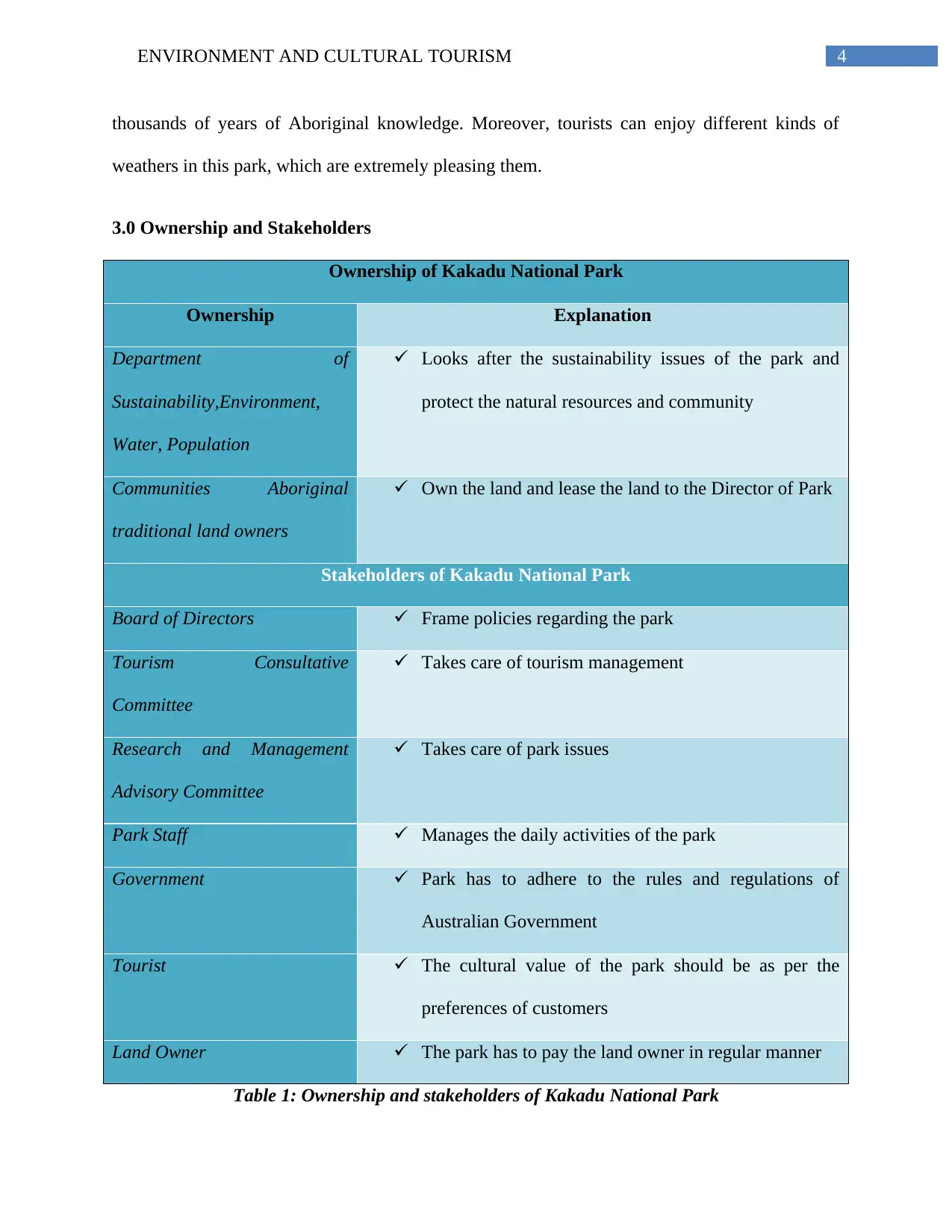
4ENVIRONMENT AND CULTURAL TOURISM
thousands of years of Aboriginal knowledge. Moreover, tourists can enjoy different kinds of
weathers in this park, which are extremely pleasing them.
3.0 Ownership and Stakeholders
Ownership of Kakadu National Park
Ownership Explanation
Department of
Sustainability,Environment,
Water, Population
Looks after the sustainability issues of the park and
protect the natural resources and community
Communities Aboriginal
traditional land owners
Own the land and lease the land to the Director of Park
Stakeholders of Kakadu National Park
Board of Directors Frame policies regarding the park
Tourism Consultative
Committee
Takes care of tourism management
Research and Management
Advisory Committee
Takes care of park issues
Park Staff Manages the daily activities of the park
Government Park has to adhere to the rules and regulations of
Australian Government
Tourist The cultural value of the park should be as per the
preferences of customers
Land Owner The park has to pay the land owner in regular manner
Table 1: Ownership and stakeholders of Kakadu National Park
thousands of years of Aboriginal knowledge. Moreover, tourists can enjoy different kinds of
weathers in this park, which are extremely pleasing them.
3.0 Ownership and Stakeholders
Ownership of Kakadu National Park
Ownership Explanation
Department of
Sustainability,Environment,
Water, Population
Looks after the sustainability issues of the park and
protect the natural resources and community
Communities Aboriginal
traditional land owners
Own the land and lease the land to the Director of Park
Stakeholders of Kakadu National Park
Board of Directors Frame policies regarding the park
Tourism Consultative
Committee
Takes care of tourism management
Research and Management
Advisory Committee
Takes care of park issues
Park Staff Manages the daily activities of the park
Government Park has to adhere to the rules and regulations of
Australian Government
Tourist The cultural value of the park should be as per the
preferences of customers
Land Owner The park has to pay the land owner in regular manner
Table 1: Ownership and stakeholders of Kakadu National Park
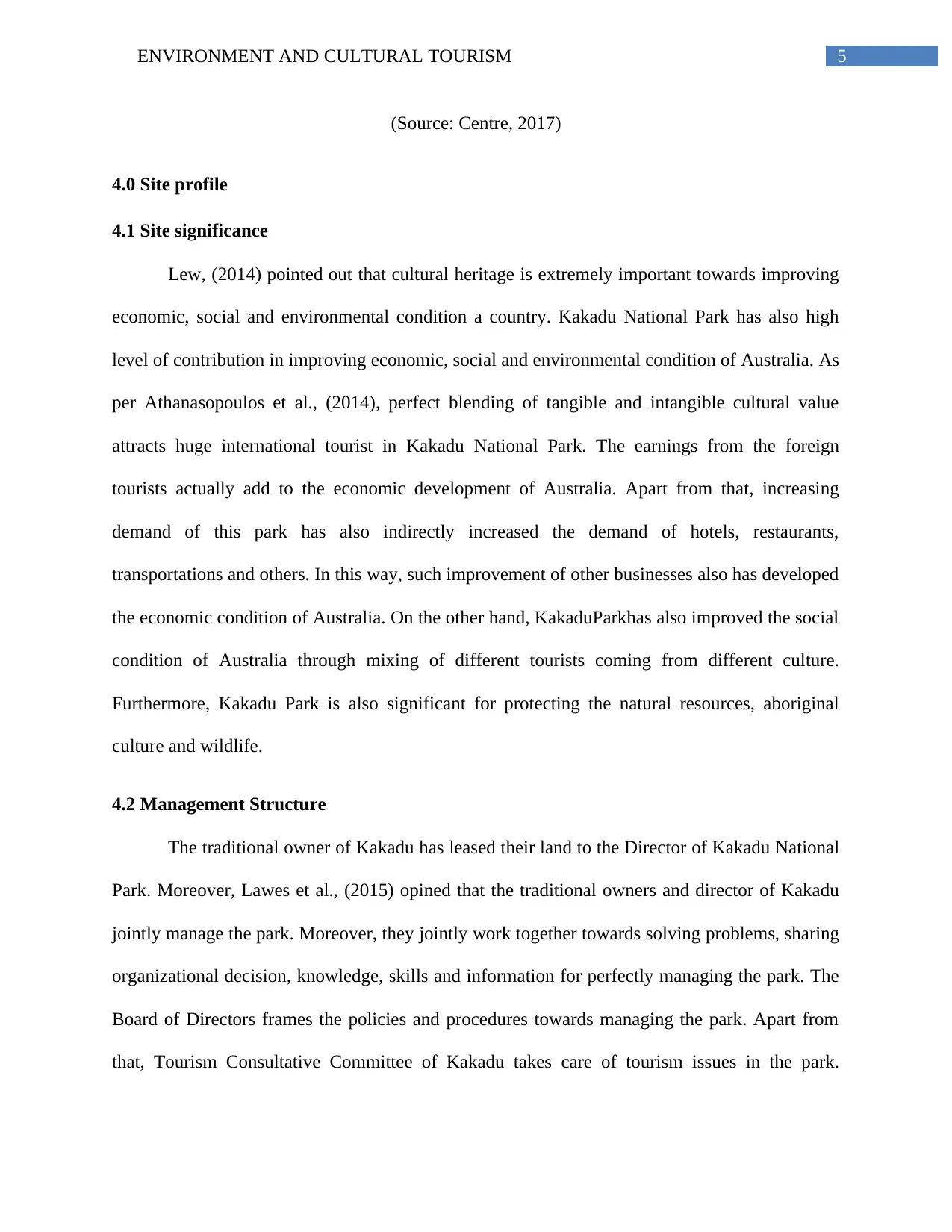
5ENVIRONMENT AND CULTURAL TOURISM
(Source: Centre, 2017)
4.0 Site profile
4.1 Site significance
Lew, (2014) pointed out that cultural heritage is extremely important towards improving
economic, social and environmental condition a country. Kakadu National Park has also high
level of contribution in improving economic, social and environmental condition of Australia. As
per Athanasopoulos et al., (2014), perfect blending of tangible and intangible cultural value
attracts huge international tourist in Kakadu National Park. The earnings from the foreign
tourists actually add to the economic development of Australia. Apart from that, increasing
demand of this park has also indirectly increased the demand of hotels, restaurants,
transportations and others. In this way, such improvement of other businesses also has developed
the economic condition of Australia. On the other hand, KakaduParkhas also improved the social
condition of Australia through mixing of different tourists coming from different culture.
Furthermore, Kakadu Park is also significant for protecting the natural resources, aboriginal
culture and wildlife.
4.2 Management Structure
The traditional owner of Kakadu has leased their land to the Director of Kakadu National
Park. Moreover, Lawes et al., (2015) opined that the traditional owners and director of Kakadu
jointly manage the park. Moreover, they jointly work together towards solving problems, sharing
organizational decision, knowledge, skills and information for perfectly managing the park. The
Board of Directors frames the policies and procedures towards managing the park. Apart from
that, Tourism Consultative Committee of Kakadu takes care of tourism issues in the park.
(Source: Centre, 2017)
4.0 Site profile
4.1 Site significance
Lew, (2014) pointed out that cultural heritage is extremely important towards improving
economic, social and environmental condition a country. Kakadu National Park has also high
level of contribution in improving economic, social and environmental condition of Australia. As
per Athanasopoulos et al., (2014), perfect blending of tangible and intangible cultural value
attracts huge international tourist in Kakadu National Park. The earnings from the foreign
tourists actually add to the economic development of Australia. Apart from that, increasing
demand of this park has also indirectly increased the demand of hotels, restaurants,
transportations and others. In this way, such improvement of other businesses also has developed
the economic condition of Australia. On the other hand, KakaduParkhas also improved the social
condition of Australia through mixing of different tourists coming from different culture.
Furthermore, Kakadu Park is also significant for protecting the natural resources, aboriginal
culture and wildlife.
4.2 Management Structure
The traditional owner of Kakadu has leased their land to the Director of Kakadu National
Park. Moreover, Lawes et al., (2015) opined that the traditional owners and director of Kakadu
jointly manage the park. Moreover, they jointly work together towards solving problems, sharing
organizational decision, knowledge, skills and information for perfectly managing the park. The
Board of Directors frames the policies and procedures towards managing the park. Apart from
that, Tourism Consultative Committee of Kakadu takes care of tourism issues in the park.
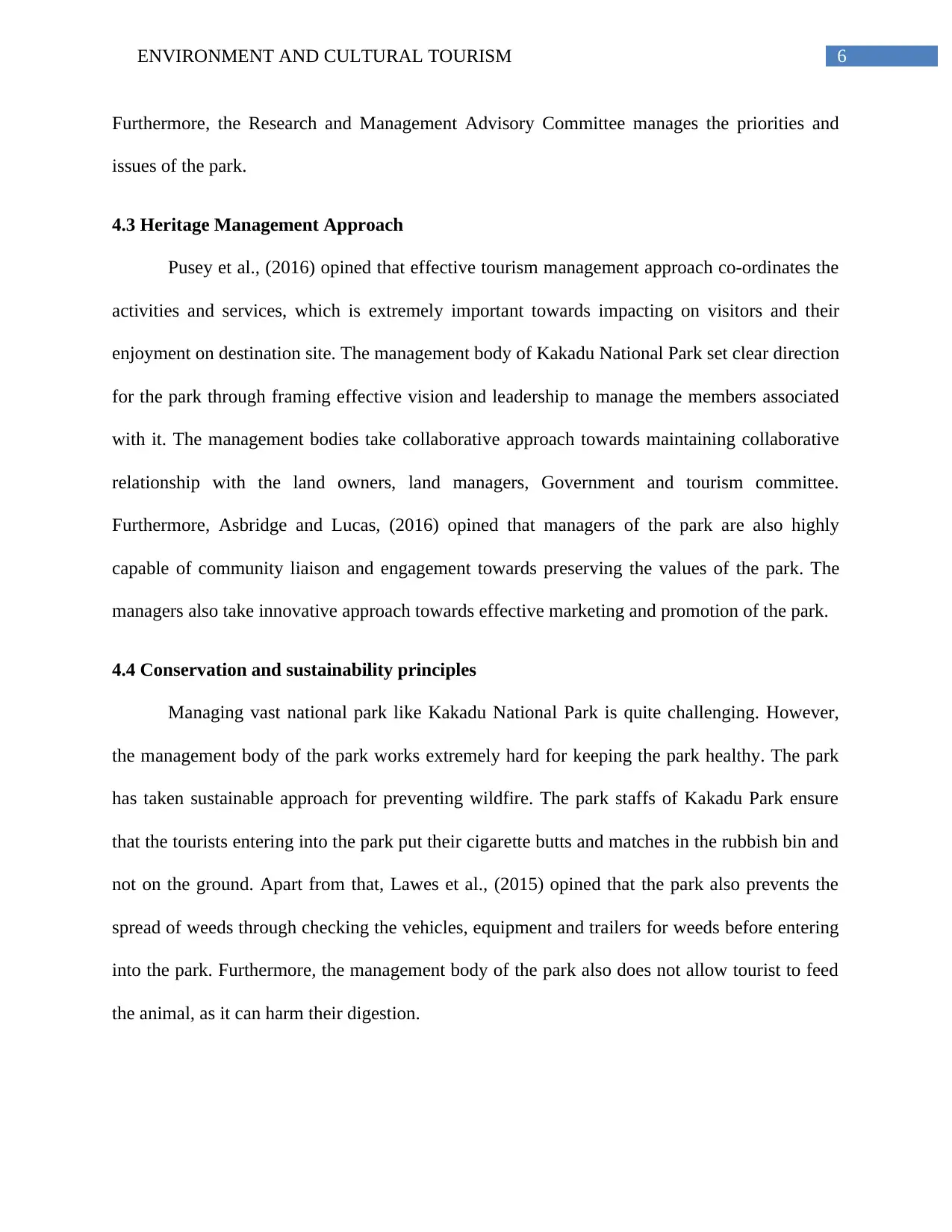
6ENVIRONMENT AND CULTURAL TOURISM
Furthermore, the Research and Management Advisory Committee manages the priorities and
issues of the park.
4.3 Heritage Management Approach
Pusey et al., (2016) opined that effective tourism management approach co-ordinates the
activities and services, which is extremely important towards impacting on visitors and their
enjoyment on destination site. The management body of Kakadu National Park set clear direction
for the park through framing effective vision and leadership to manage the members associated
with it. The management bodies take collaborative approach towards maintaining collaborative
relationship with the land owners, land managers, Government and tourism committee.
Furthermore, Asbridge and Lucas, (2016) opined that managers of the park are also highly
capable of community liaison and engagement towards preserving the values of the park. The
managers also take innovative approach towards effective marketing and promotion of the park.
4.4 Conservation and sustainability principles
Managing vast national park like Kakadu National Park is quite challenging. However,
the management body of the park works extremely hard for keeping the park healthy. The park
has taken sustainable approach for preventing wildfire. The park staffs of Kakadu Park ensure
that the tourists entering into the park put their cigarette butts and matches in the rubbish bin and
not on the ground. Apart from that, Lawes et al., (2015) opined that the park also prevents the
spread of weeds through checking the vehicles, equipment and trailers for weeds before entering
into the park. Furthermore, the management body of the park also does not allow tourist to feed
the animal, as it can harm their digestion.
Furthermore, the Research and Management Advisory Committee manages the priorities and
issues of the park.
4.3 Heritage Management Approach
Pusey et al., (2016) opined that effective tourism management approach co-ordinates the
activities and services, which is extremely important towards impacting on visitors and their
enjoyment on destination site. The management body of Kakadu National Park set clear direction
for the park through framing effective vision and leadership to manage the members associated
with it. The management bodies take collaborative approach towards maintaining collaborative
relationship with the land owners, land managers, Government and tourism committee.
Furthermore, Asbridge and Lucas, (2016) opined that managers of the park are also highly
capable of community liaison and engagement towards preserving the values of the park. The
managers also take innovative approach towards effective marketing and promotion of the park.
4.4 Conservation and sustainability principles
Managing vast national park like Kakadu National Park is quite challenging. However,
the management body of the park works extremely hard for keeping the park healthy. The park
has taken sustainable approach for preventing wildfire. The park staffs of Kakadu Park ensure
that the tourists entering into the park put their cigarette butts and matches in the rubbish bin and
not on the ground. Apart from that, Lawes et al., (2015) opined that the park also prevents the
spread of weeds through checking the vehicles, equipment and trailers for weeds before entering
into the park. Furthermore, the management body of the park also does not allow tourist to feed
the animal, as it can harm their digestion.
Paraphrase This Document
Need a fresh take? Get an instant paraphrase of this document with our AI Paraphraser
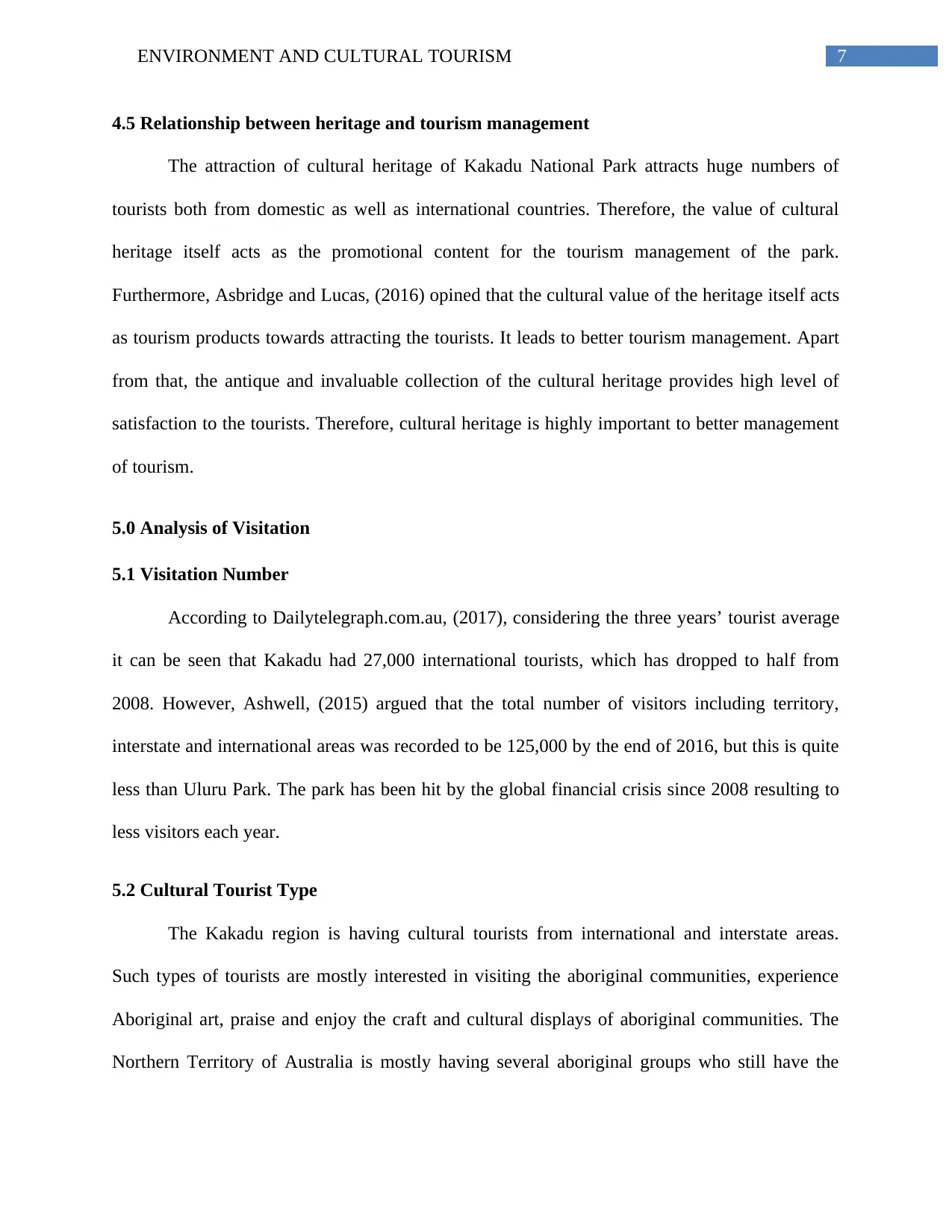
7ENVIRONMENT AND CULTURAL TOURISM
4.5 Relationship between heritage and tourism management
The attraction of cultural heritage of Kakadu National Park attracts huge numbers of
tourists both from domestic as well as international countries. Therefore, the value of cultural
heritage itself acts as the promotional content for the tourism management of the park.
Furthermore, Asbridge and Lucas, (2016) opined that the cultural value of the heritage itself acts
as tourism products towards attracting the tourists. It leads to better tourism management. Apart
from that, the antique and invaluable collection of the cultural heritage provides high level of
satisfaction to the tourists. Therefore, cultural heritage is highly important to better management
of tourism.
5.0 Analysis of Visitation
5.1 Visitation Number
According to Dailytelegraph.com.au, (2017), considering the three years’ tourist average
it can be seen that Kakadu had 27,000 international tourists, which has dropped to half from
2008. However, Ashwell, (2015) argued that the total number of visitors including territory,
interstate and international areas was recorded to be 125,000 by the end of 2016, but this is quite
less than Uluru Park. The park has been hit by the global financial crisis since 2008 resulting to
less visitors each year.
5.2 Cultural Tourist Type
The Kakadu region is having cultural tourists from international and interstate areas.
Such types of tourists are mostly interested in visiting the aboriginal communities, experience
Aboriginal art, praise and enjoy the craft and cultural displays of aboriginal communities. The
Northern Territory of Australia is mostly having several aboriginal groups who still have the
4.5 Relationship between heritage and tourism management
The attraction of cultural heritage of Kakadu National Park attracts huge numbers of
tourists both from domestic as well as international countries. Therefore, the value of cultural
heritage itself acts as the promotional content for the tourism management of the park.
Furthermore, Asbridge and Lucas, (2016) opined that the cultural value of the heritage itself acts
as tourism products towards attracting the tourists. It leads to better tourism management. Apart
from that, the antique and invaluable collection of the cultural heritage provides high level of
satisfaction to the tourists. Therefore, cultural heritage is highly important to better management
of tourism.
5.0 Analysis of Visitation
5.1 Visitation Number
According to Dailytelegraph.com.au, (2017), considering the three years’ tourist average
it can be seen that Kakadu had 27,000 international tourists, which has dropped to half from
2008. However, Ashwell, (2015) argued that the total number of visitors including territory,
interstate and international areas was recorded to be 125,000 by the end of 2016, but this is quite
less than Uluru Park. The park has been hit by the global financial crisis since 2008 resulting to
less visitors each year.
5.2 Cultural Tourist Type
The Kakadu region is having cultural tourists from international and interstate areas.
Such types of tourists are mostly interested in visiting the aboriginal communities, experience
Aboriginal art, praise and enjoy the craft and cultural displays of aboriginal communities. The
Northern Territory of Australia is mostly having several aboriginal groups who still have the
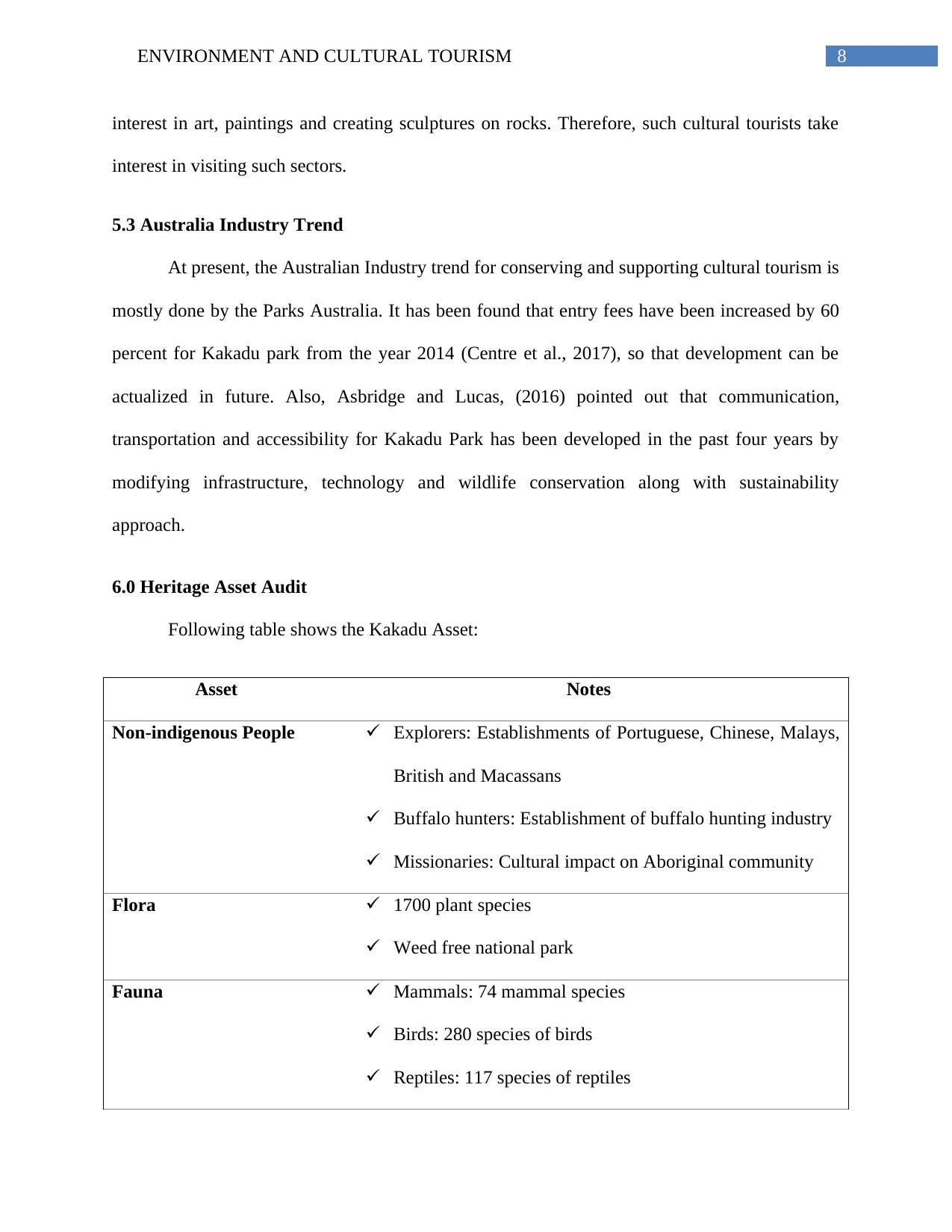
8ENVIRONMENT AND CULTURAL TOURISM
interest in art, paintings and creating sculptures on rocks. Therefore, such cultural tourists take
interest in visiting such sectors.
5.3 Australia Industry Trend
At present, the Australian Industry trend for conserving and supporting cultural tourism is
mostly done by the Parks Australia. It has been found that entry fees have been increased by 60
percent for Kakadu park from the year 2014 (Centre et al., 2017), so that development can be
actualized in future. Also, Asbridge and Lucas, (2016) pointed out that communication,
transportation and accessibility for Kakadu Park has been developed in the past four years by
modifying infrastructure, technology and wildlife conservation along with sustainability
approach.
6.0 Heritage Asset Audit
Following table shows the Kakadu Asset:
Asset Notes
Non-indigenous People Explorers: Establishments of Portuguese, Chinese, Malays,
British and Macassans
Buffalo hunters: Establishment of buffalo hunting industry
Missionaries: Cultural impact on Aboriginal community
Flora 1700 plant species
Weed free national park
Fauna Mammals: 74 mammal species
Birds: 280 species of birds
Reptiles: 117 species of reptiles
interest in art, paintings and creating sculptures on rocks. Therefore, such cultural tourists take
interest in visiting such sectors.
5.3 Australia Industry Trend
At present, the Australian Industry trend for conserving and supporting cultural tourism is
mostly done by the Parks Australia. It has been found that entry fees have been increased by 60
percent for Kakadu park from the year 2014 (Centre et al., 2017), so that development can be
actualized in future. Also, Asbridge and Lucas, (2016) pointed out that communication,
transportation and accessibility for Kakadu Park has been developed in the past four years by
modifying infrastructure, technology and wildlife conservation along with sustainability
approach.
6.0 Heritage Asset Audit
Following table shows the Kakadu Asset:
Asset Notes
Non-indigenous People Explorers: Establishments of Portuguese, Chinese, Malays,
British and Macassans
Buffalo hunters: Establishment of buffalo hunting industry
Missionaries: Cultural impact on Aboriginal community
Flora 1700 plant species
Weed free national park
Fauna Mammals: 74 mammal species
Birds: 280 species of birds
Reptiles: 117 species of reptiles
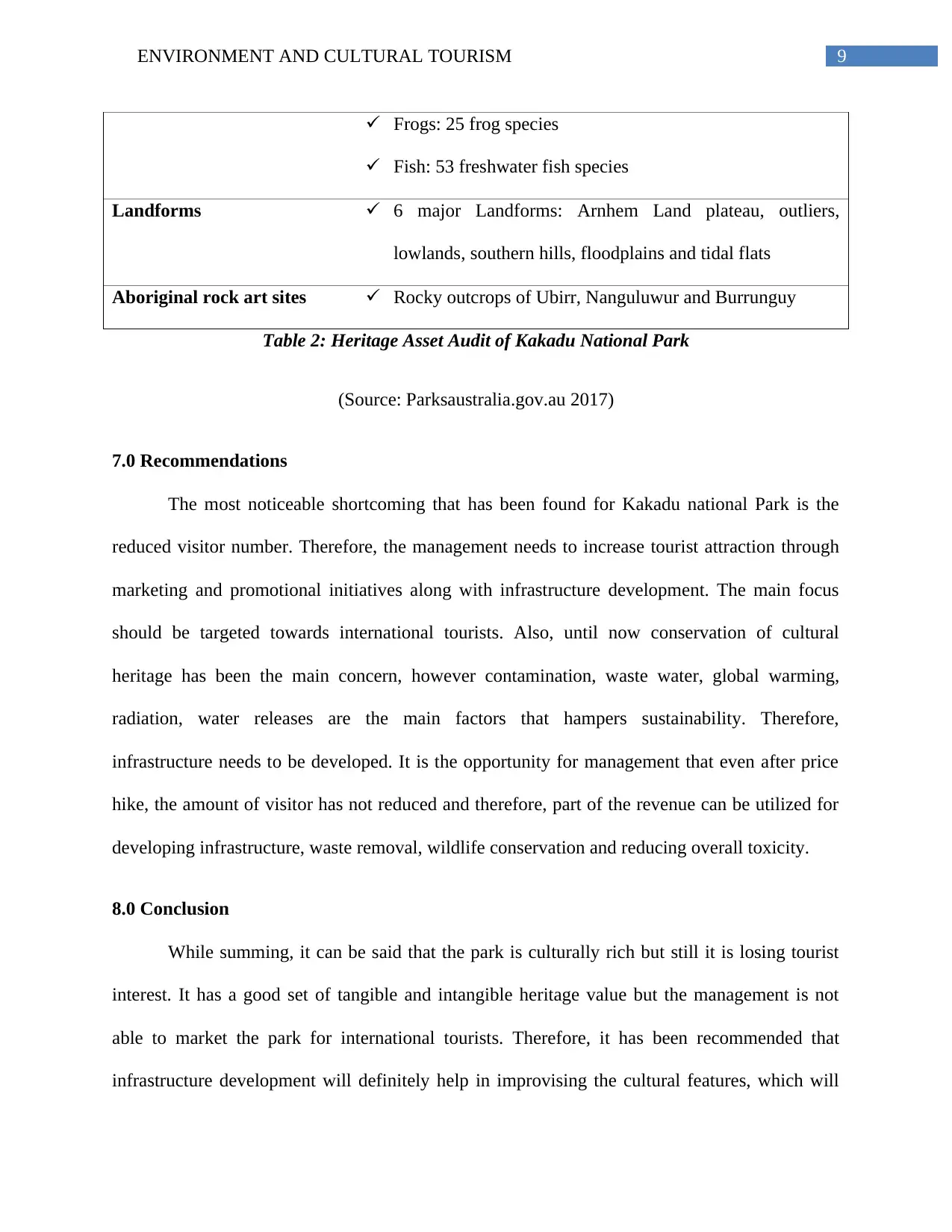
9ENVIRONMENT AND CULTURAL TOURISM
Frogs: 25 frog species
Fish: 53 freshwater fish species
Landforms 6 major Landforms: Arnhem Land plateau, outliers,
lowlands, southern hills, floodplains and tidal flats
Aboriginal rock art sites Rocky outcrops of Ubirr, Nanguluwur and Burrunguy
Table 2: Heritage Asset Audit of Kakadu National Park
(Source: Parksaustralia.gov.au 2017)
7.0 Recommendations
The most noticeable shortcoming that has been found for Kakadu national Park is the
reduced visitor number. Therefore, the management needs to increase tourist attraction through
marketing and promotional initiatives along with infrastructure development. The main focus
should be targeted towards international tourists. Also, until now conservation of cultural
heritage has been the main concern, however contamination, waste water, global warming,
radiation, water releases are the main factors that hampers sustainability. Therefore,
infrastructure needs to be developed. It is the opportunity for management that even after price
hike, the amount of visitor has not reduced and therefore, part of the revenue can be utilized for
developing infrastructure, waste removal, wildlife conservation and reducing overall toxicity.
8.0 Conclusion
While summing, it can be said that the park is culturally rich but still it is losing tourist
interest. It has a good set of tangible and intangible heritage value but the management is not
able to market the park for international tourists. Therefore, it has been recommended that
infrastructure development will definitely help in improvising the cultural features, which will
Frogs: 25 frog species
Fish: 53 freshwater fish species
Landforms 6 major Landforms: Arnhem Land plateau, outliers,
lowlands, southern hills, floodplains and tidal flats
Aboriginal rock art sites Rocky outcrops of Ubirr, Nanguluwur and Burrunguy
Table 2: Heritage Asset Audit of Kakadu National Park
(Source: Parksaustralia.gov.au 2017)
7.0 Recommendations
The most noticeable shortcoming that has been found for Kakadu national Park is the
reduced visitor number. Therefore, the management needs to increase tourist attraction through
marketing and promotional initiatives along with infrastructure development. The main focus
should be targeted towards international tourists. Also, until now conservation of cultural
heritage has been the main concern, however contamination, waste water, global warming,
radiation, water releases are the main factors that hampers sustainability. Therefore,
infrastructure needs to be developed. It is the opportunity for management that even after price
hike, the amount of visitor has not reduced and therefore, part of the revenue can be utilized for
developing infrastructure, waste removal, wildlife conservation and reducing overall toxicity.
8.0 Conclusion
While summing, it can be said that the park is culturally rich but still it is losing tourist
interest. It has a good set of tangible and intangible heritage value but the management is not
able to market the park for international tourists. Therefore, it has been recommended that
infrastructure development will definitely help in improvising the cultural features, which will
Secure Best Marks with AI Grader
Need help grading? Try our AI Grader for instant feedback on your assignments.

10ENVIRONMENT AND CULTURAL TOURISM
eventually attract more visitors through intense marketing and promotional strategies. Also, the
management has the opportunity to allocate part of revenue for the park development in future.
eventually attract more visitors through intense marketing and promotional strategies. Also, the
management has the opportunity to allocate part of revenue for the park development in future.
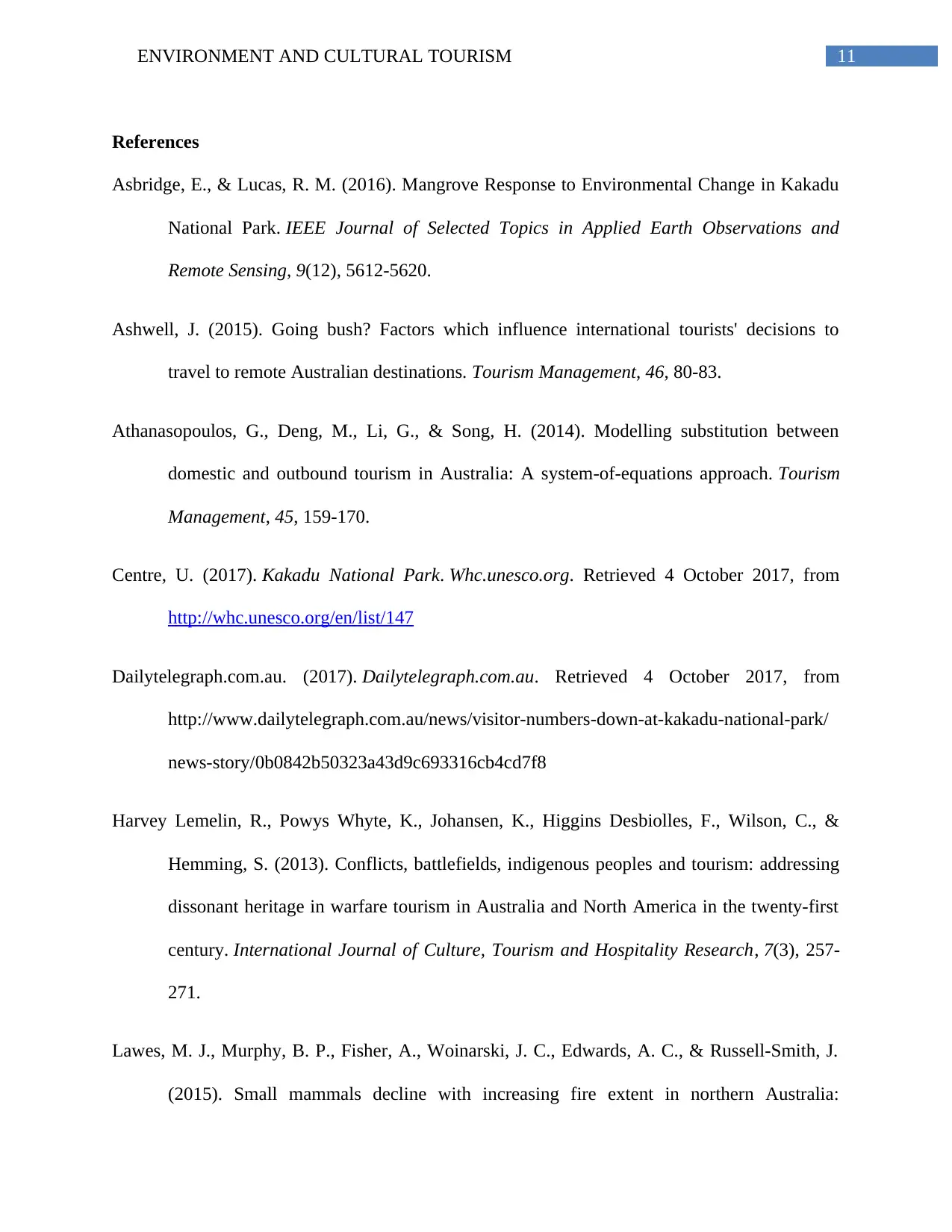
11ENVIRONMENT AND CULTURAL TOURISM
References
Asbridge, E., & Lucas, R. M. (2016). Mangrove Response to Environmental Change in Kakadu
National Park. IEEE Journal of Selected Topics in Applied Earth Observations and
Remote Sensing, 9(12), 5612-5620.
Ashwell, J. (2015). Going bush? Factors which influence international tourists' decisions to
travel to remote Australian destinations. Tourism Management, 46, 80-83.
Athanasopoulos, G., Deng, M., Li, G., & Song, H. (2014). Modelling substitution between
domestic and outbound tourism in Australia: A system-of-equations approach. Tourism
Management, 45, 159-170.
Centre, U. (2017). Kakadu National Park. Whc.unesco.org. Retrieved 4 October 2017, from
http://whc.unesco.org/en/list/147
Dailytelegraph.com.au. (2017). Dailytelegraph.com.au. Retrieved 4 October 2017, from
http://www.dailytelegraph.com.au/news/visitor-numbers-down-at-kakadu-national-park/
news-story/0b0842b50323a43d9c693316cb4cd7f8
Harvey Lemelin, R., Powys Whyte, K., Johansen, K., Higgins Desbiolles, F., Wilson, C., &
Hemming, S. (2013). Conflicts, battlefields, indigenous peoples and tourism: addressing
dissonant heritage in warfare tourism in Australia and North America in the twenty-first
century. International Journal of Culture, Tourism and Hospitality Research, 7(3), 257-
271.
Lawes, M. J., Murphy, B. P., Fisher, A., Woinarski, J. C., Edwards, A. C., & Russell-Smith, J.
(2015). Small mammals decline with increasing fire extent in northern Australia:
References
Asbridge, E., & Lucas, R. M. (2016). Mangrove Response to Environmental Change in Kakadu
National Park. IEEE Journal of Selected Topics in Applied Earth Observations and
Remote Sensing, 9(12), 5612-5620.
Ashwell, J. (2015). Going bush? Factors which influence international tourists' decisions to
travel to remote Australian destinations. Tourism Management, 46, 80-83.
Athanasopoulos, G., Deng, M., Li, G., & Song, H. (2014). Modelling substitution between
domestic and outbound tourism in Australia: A system-of-equations approach. Tourism
Management, 45, 159-170.
Centre, U. (2017). Kakadu National Park. Whc.unesco.org. Retrieved 4 October 2017, from
http://whc.unesco.org/en/list/147
Dailytelegraph.com.au. (2017). Dailytelegraph.com.au. Retrieved 4 October 2017, from
http://www.dailytelegraph.com.au/news/visitor-numbers-down-at-kakadu-national-park/
news-story/0b0842b50323a43d9c693316cb4cd7f8
Harvey Lemelin, R., Powys Whyte, K., Johansen, K., Higgins Desbiolles, F., Wilson, C., &
Hemming, S. (2013). Conflicts, battlefields, indigenous peoples and tourism: addressing
dissonant heritage in warfare tourism in Australia and North America in the twenty-first
century. International Journal of Culture, Tourism and Hospitality Research, 7(3), 257-
271.
Lawes, M. J., Murphy, B. P., Fisher, A., Woinarski, J. C., Edwards, A. C., & Russell-Smith, J.
(2015). Small mammals decline with increasing fire extent in northern Australia:
1 out of 12
Your All-in-One AI-Powered Toolkit for Academic Success.
+13062052269
info@desklib.com
Available 24*7 on WhatsApp / Email
![[object Object]](/_next/static/media/star-bottom.7253800d.svg)
Unlock your academic potential
© 2024 | Zucol Services PVT LTD | All rights reserved.



